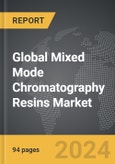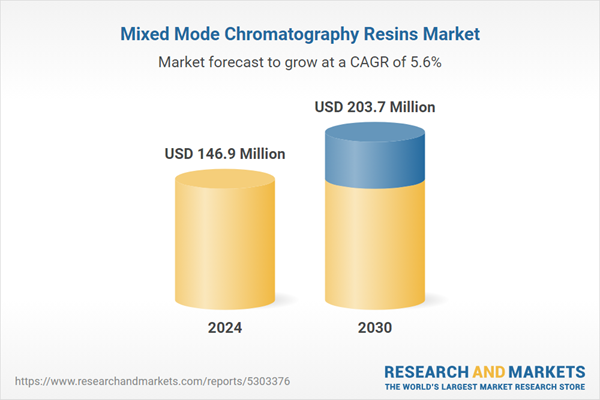Global Mixed Mode Chromatography Resins Market - Key Trends and Drivers Summarized
How Is Mixed Mode Chromatography Revolutionizing Biomolecule Separation?
Mixed mode chromatography resins are specialized materials used in the separation and purification of biomolecules, such as proteins, antibodies, and nucleic acids. These resins utilize a combination of different interaction modes, such as ion exchange, hydrophobic interaction, and affinity chromatography, to improve the efficiency and selectivity of the purification process. The adoption of mixed mode chromatography is gaining traction in the biopharmaceutical industry, where there is a growing need for high-purity and cost-effective separation techniques for complex biological products. The versatility of mixed mode chromatography resins makes them suitable for various applications, including the purification of monoclonal antibodies, recombinant proteins, and vaccine components. They are particularly valuable for purifying biomolecules that are challenging to separate using traditional single-mode chromatography techniques. The ability to achieve high resolution and selectivity in a single step can significantly reduce the number of purification steps required, thereby saving time and reducing costs.What Innovations Are Shaping the Mixed Mode Chromatography Resins Market?
Several innovations are driving the development of mixed mode chromatography resins, including advances in resin design, enhanced ligand chemistry, and the incorporation of novel materials. Companies are focusing on developing resins that offer higher binding capacities and better selectivity for target molecules. The introduction of new ligands that can operate under a wider range of pH conditions and ionic strengths is expanding the applicability of mixed mode chromatography across different types of biomolecules. Automation and process control are also enhancing the adoption of mixed mode chromatography in industrial-scale purification. Automated chromatography systems can be programmed to optimize process parameters for specific resins, ensuring consistent and high-quality separations. The integration of continuous chromatography techniques, where mixed mode resins are used in continuous processing formats, is emerging as a trend in biomanufacturing, allowing for more efficient purification workflows.How Do Market Segments Define the Growth of Mixed Mode Chromatography Resins?
Techniques include hydrophobic interaction, ion exchange, and multimodal chromatography, with multimodal chromatography being one of the most widely used due to its ability to combine different interaction mechanisms for improved selectivity. Applications encompass antibody purification, protein purification, and others, with antibody purification accounting for a significant market share due to the growing demand for monoclonal antibodies in therapeutic applications. End-users of mixed mode chromatography resins include biopharmaceutical companies, research institutions, and contract research organizations (CROs). Biopharmaceutical companies represent the largest end-user segment, driven by the need to improve purification processes and reduce manufacturing costs. Geographically, North America leads the market due to a strong presence of biopharmaceutical companies and advanced research infrastructure, while Asia-Pacific is experiencing rapid growth owing to increasing biopharmaceutical investments and research activities.What Factors Are Driving the Growth in the Mixed Mode Chromatography Resins Market?
The growth in the mixed mode chromatography resins market is driven by several factors, including the increasing demand for biopharmaceuticals, the need for cost-effective purification techniques, and advancements in resin technology. As the biopharmaceutical industry expands, there is a growing need for high-purity separation techniques to produce therapeutic proteins, antibodies, and vaccines. The ability of mixed mode chromatography to simplify purification workflows and reduce the number of steps required is appealing to manufacturers looking to optimize production costs. Additionally, the development of novel resins with enhanced binding capacities and the integration of automation in chromatography processes are further propelling market growth.Report Scope
The report analyzes the Mixed Mode Chromatography Resins market, presented in terms of market value (US$ Thousand). The analysis covers the key segments and geographic regions outlined below.- Segments: Technique (Ion Exchange - Hydrophobic, Hydroxyapatite, Other Techniques); Application (Polyclonal Antibodies, Non-Antibody Protein, Monoclonal Antibodies).
- Geographic Regions/Countries:World; United States; Canada; Japan; China; Europe (France; Germany; Italy; United Kingdom; and Rest of Europe); Asia-Pacific; Rest of World.
Key Insights:
- Market Growth: Understand the significant growth trajectory of the Ion Exchange - Hydrophobic Technique segment, which is expected to reach US$107.8 Million by 2030 with a CAGR of a 6.2%. The Hydroxyapatite Technique segment is also set to grow at 5.2% CAGR over the analysis period.
- Regional Analysis: Gain insights into the U.S. market, valued at $40.5 Million in 2024, and China, forecasted to grow at an impressive 5.3% CAGR to reach $31.8 Million by 2030. Discover growth trends in other key regions, including Japan, Canada, Germany, and the Asia-Pacific.
Why You Should Buy This Report:
- Detailed Market Analysis: Access a thorough analysis of the Global Mixed Mode Chromatography Resins Market, covering all major geographic regions and market segments.
- Competitive Insights: Get an overview of the competitive landscape, including the market presence of major players across different geographies.
- Future Trends and Drivers: Understand the key trends and drivers shaping the future of the Global Mixed Mode Chromatography Resins Market.
- Actionable Insights: Benefit from actionable insights that can help you identify new revenue opportunities and make strategic business decisions.
Key Questions Answered:
- How is the Global Mixed Mode Chromatography Resins Market expected to evolve by 2030?
- What are the main drivers and restraints affecting the market?
- Which market segments will grow the most over the forecast period?
- How will market shares for different regions and segments change by 2030?
- Who are the leading players in the market, and what are their prospects?
Report Features:
- Comprehensive Market Data: Independent analysis of annual sales and market forecasts in US$ Million from 2024 to 2030.
- In-Depth Regional Analysis: Detailed insights into key markets, including the U.S., China, Japan, Canada, Europe, Asia-Pacific, Latin America, Middle East, and Africa.
- Company Profiles: Coverage of players such as Bio-Rad Laboratories, Bio-Works Company Ltd., Danaher Corporation, GE Healthcare Life Sciences, JSR Micro Inc. and more.
- Complimentary Updates: Receive free report updates for one year to keep you informed of the latest market developments.
Some of the 43 companies featured in this Mixed Mode Chromatography Resins market report include:
- Bio-Rad Laboratories
- Bio-Works Company Ltd.
- Danaher Corporation
- GE Healthcare Life Sciences
- JSR Micro Inc.
- Kaneka Corporation
- Knauer Gmbh
- Life Technology Corporation
- Merck
- Pall Corporation
- Purolite Corporation
- Sepragen Corporation
- Thermo Fisher Scientific
- Tosoh Corporation
This edition integrates the latest global trade and economic shifts into comprehensive market analysis. Key updates include:
- Tariff and Trade Impact: Insights into global tariff negotiations across 180+ countries, with analysis of supply chain turbulence, sourcing disruptions, and geographic realignment. Special focus on 2025 as a pivotal year for trade tensions, including updated perspectives on the Trump-era tariffs.
- Adjusted Forecasts and Analytics: Revised global and regional market forecasts through 2030, incorporating tariff effects, economic uncertainty, and structural changes in globalization. Includes historical analysis from 2015 to 2023.
- Strategic Market Dynamics: Evaluation of revised market prospects, regional outlooks, and key economic indicators such as population and urbanization trends.
- Innovation & Technology Trends: Latest developments in product and process innovation, emerging technologies, and key industry drivers shaping the competitive landscape.
- Competitive Intelligence: Updated global market share estimates for 2025, competitive positioning of major players (Strong/Active/Niche/Trivial), and refined focus on leading global brands and core players.
- Expert Insight & Commentary: Strategic analysis from economists, trade experts, and domain specialists to contextualize market shifts and identify emerging opportunities.
Table of Contents
Companies Mentioned (Partial List)
A selection of companies mentioned in this report includes, but is not limited to:
- Bio-Rad Laboratories
- Bio-Works Company Ltd.
- Danaher Corporation
- GE Healthcare Life Sciences
- JSR Micro Inc.
- Kaneka Corporation
- Knauer Gmbh
- Life Technology Corporation
- Merck
- Pall Corporation
- Purolite Corporation
- Sepragen Corporation
- Thermo Fisher Scientific
- Tosoh Corporation
Table Information
| Report Attribute | Details |
|---|---|
| No. of Pages | 178 |
| Published | December 2025 |
| Forecast Period | 2024 - 2030 |
| Estimated Market Value ( USD | $ 146.9 Million |
| Forecasted Market Value ( USD | $ 203.7 Million |
| Compound Annual Growth Rate | 5.6% |
| Regions Covered | Global |









